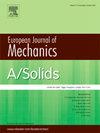Enhancing bending and compression resistance of additively manufactured bio-inspired architected structures
IF 4.4
2区 工程技术
Q1 MECHANICS
引用次数: 0
Abstract
To tackle the challenge of optimizing structural performance and minimizing weight, this research explores the potential of multi-scale bio-inspired design principles in combination with 3D printing. Besides, multi-objective genetic algorithm-based optimization strategies are applied to enhance structure bending and compression resistance. Hollow cylinders, commonly used in piping, structural supports, and biomedical implants, are ideal for this approach as reducing their weight often compromises stiffness and stability, highlighting the need for new design strategies. Herein, the successful combination of bio-inspiration, including plant- and animal-based solutions, and multi-objective optimization plays a core role in the architected structure design to minimize volume and maximize reaction force. Among the various bio-inspired models evaluated, the Horsetail structure has emerged as the most effective, demonstrating 100% increase in the reaction force under bending loads, a 40% improvement in maximum displacement before instability, and a 20% increase in compressive resistance if compared to the reference hollow cylinder. Validation through a combined experimental and numerical approach confirms the accuracy and reliability of the developed models. The successful application of the Material Extrusion process to fabricate these bio-inspired structures proves their practical feasibility. Here, integrating these optimized designs into real-world applications can replace conventional cylindrical pylons with lighter, load-optimized 3D-printed alternatives.
求助全文
约1分钟内获得全文
求助全文
来源期刊
CiteScore
7.00
自引率
7.30%
发文量
275
审稿时长
48 days
期刊介绍:
The European Journal of Mechanics endash; A/Solids continues to publish articles in English in all areas of Solid Mechanics from the physical and mathematical basis to materials engineering, technological applications and methods of modern computational mechanics, both pure and applied research.

 求助内容:
求助内容: 应助结果提醒方式:
应助结果提醒方式:


